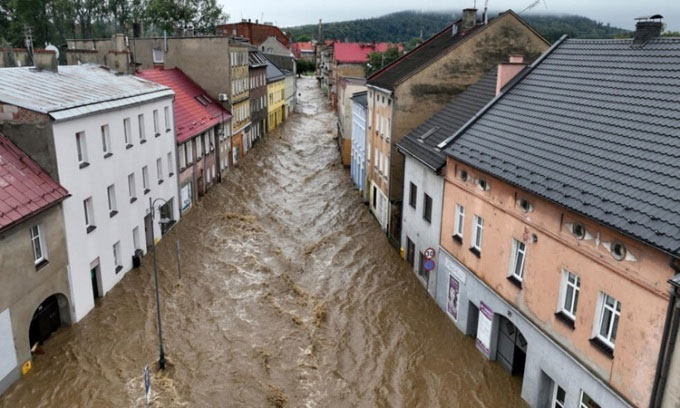Global rainstorms tied to unusually wet September
Rising ocean and land temperatures provide extra heat and moisture, helping storms intensify and bring heavy rain around the world.
Typhoon Yagi devastated Asia, Typhoon Boris caused widespread flooding in Europe, severe flooding in the Sahel and Hurricane Helene battered Florida, making September a particularly wet month. But while scientists can directly link some extreme weather events to man-made global warming, it is too early to draw conclusions about the month of storms, according to AFP .

Flooded streets in Glucholazy, Poland, in September 2024. (Photo: Sergei GAPON/AFP).
'There have always been extreme weather events, but their intensity has been amplified by global warming, especially in terms of rainfall ,' said researcher Paulo Ceppi of the Grantham Institute at Imperial College London. 'It could be one of the common drivers of different events in many parts of the world.'
Early indications from monthly data suggest record rainfall in the affected areas. In central Europe, the torrential rains that accompanied Storm Boris were the heaviest on record in the region, flooding homes and farms, according to the World Weather Attribution (WWA) network of scientists. Global warming has made four- day downpours twice as likely compared to pre-industrial times, and the damage from climate change is accelerating.
Meanwhile, in Japan's Wajima city, authorities recorded more than 120 mm of rain per hour from Typhoon Yagi on the morning of September 21, the heaviest rainfall since comparable data began in 1929.
'It's very difficult to attribute different weather patterns around the world to climate change,' says Liz Stephens, head of the Red Crescent Climate Center. 'But the basic principle is that for every degree Celsius of warming, the atmosphere can hold 7% more moisture.'
With global warming on track to exceed 1.5 degrees Celsius above pre-industrial levels, we can calculate the impact pretty quickly. The summer of 2024 is set to see the highest global temperatures ever recorded, beating last year's record, according to the EU's Copernicus climate monitoring programme.
This year's hot Mediterranean summer has added evaporation, dumping more rain on Europe if conditions are right, causing all that moisture to fall into a few places, Ceppi said. Global temperatures over both land and ocean were unusually high in August and September despite La Nina-like conditions developing in the Pacific , said Roxy Mathew Koll, a researcher at the Indian Institute of Tropical Meteorology. The high temperatures help provide extra heat and moisture for storms to intensify.
La Nina is a natural climate phenomenon that causes cooler ocean surface temperatures in the tropical Pacific Ocean, combined with changes in winds, rainfall, and atmospheric pressure. In many places, especially in the tropics, La Nina has the opposite climate effects to El Nino. El Nino warms the ocean surface, leading to drought in some parts of the world and heavy rain in others. Currently, the neutral phase is occurring, meaning neither El Nino nor La Nina is present .
- Agent CIA instructs the skills to get rid of zip straps
- Survival tips: Escape skills drown when tied up
- The truth about Vietnam's strange 'tied her up' bird
- Global chip sales in September reached a record
- Net is being attacked violently abnormally
- Europe: unusually hot weather
- Global climate warm record in 2005
- Open XML has not become an international standard
- Unusual summer alerts in the tropics
- Scientists predict when a global catastrophe will happen
- Moonlight: Why is the moon red and big unusually?
- Why is Hanoi unusually hot in winter?
 Is the magnetic North Pole shift dangerous to humanity?
Is the magnetic North Pole shift dangerous to humanity? Washington legalizes the recycling of human bodies into fertilizer
Washington legalizes the recycling of human bodies into fertilizer Lightning stone - the mysterious guest
Lightning stone - the mysterious guest Stunned by the mysterious sunset, strange appearance
Stunned by the mysterious sunset, strange appearance